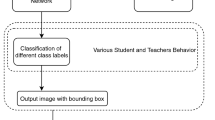Abstract
The examination evaluates the learners’ ability to achieve a specific goal, representing a crucial assessment of the knowledge acquired during the learning process. To attain success in the examination, it is imperative to prevent cheating in the examination hall. Despite this, cheating still occurs due to the limited availability of human resources. Therefore, we have collected surveillance videos of examination halls from a high school in Vietnam to analyze and implement deep learning architectures such as You Only Look Once (YOLO) and Single Shot Detector (SSD) MobileNet V2 to detect anomalous behavior among students during the examination. Our study focuses on detecting five common abnormal behaviors, including looking around, bending over the desk, putting one or two hands under the table, waving, and standing up. YOLO achieved the best results, with a performance of 83.55%, 99.65%, 97%, 99.2%, and 98.0866% in Intersection over Union (IoU), Mean Average Precision (mAP), Precision, Recall, and F1-Score, respectively, across 2639 images. This approach is expected to assist educators and teachers in detecting and preventing cheating activities in examination rooms.
Access this chapter
Tax calculation will be finalised at checkout
Purchases are for personal use only
Similar content being viewed by others
References
Rohini, V., Sobhana, M., Chowdary, C.S.: Attendance monitoring system design based on face segmentation and recognition. Recent Patents Eng. 17(2), 82–89 (2023). https://doi.org/10.2174/1872212116666220401154639
Budiman, A., Yaputera, R.A., Achmad, S., Kurniawan, A.: Student attendance with face recognition (LBPH or CNN) systematic literature review. Proc. Comput. Sci. 216, 31–38 (2023). https://doi.org/10.1016/j.procs.2022.12.108
Li, D., Qu, P., Jin, T., Chen, C., Bai, Y.: An anomaly detection of learning behaviour data based on discrete Markov chain. Int. J. Continuing Eng. Educ. Life-Long Learn. 33(1), 69 (2023). https://doi.org/10.1504/ijceell.2023.127872
Wei, F.: Study on behaviour anomaly detection method of English online learning based on feature extraction. Int. J. Reason. Based Intell. Syst. 15(1), 41 (2023). https://doi.org/10.1504/ijris.2023.128372
Redmon, J., Divvala, S., Girshick, R., Farhadi, A.: You only look once: unified, real-time object detection (2015). https://arxiv.org/abs/1506.02640
Sandler, M., Howard, A., Zhu, M., Zhmoginov, A., Chen, L.C.: Mobilenetv 2: inverted residuals and linear bottlenecks (2018). https://arxiv.org/abs/1801.04381
Cao, Z., Simon, T., Wei, S.E., Sheikh, Y.: Realtime multi-person 2d pose estimation using part affinity fields. In: Proceedings of the IEEE Conference on Computer Vision and Pattern Recognition, pp. 7291–7299 (2017)
Yu, B.: Design and implementation of behavior recognition system based on convolutional neural network. In: ITM Web of Conferences, vol. 12, p. 01025. EDP Sciences (2017)
Xu, H., Li, L., Fang, M., Zhang, F.: Movement human actions recognition based on machine learning. Int. J. Online Eng. 14(4), 193–210 (2018)
Song, L., Liu, B., Zhu, H., Chu, Q., Yu, N.: Abnormal behavior detection based on target analysis. arXiv preprint arXiv:2107.13706 (2021)
Ullah, F.U.M., Ullah, A., Muhammad, K., Haq, I.U., Baik, S.W.: Violence detection using spatiotemporal features with 3d convolutional neural network. Sensors 19(11), 2472 (2019)
Lina, W., Ding, J.: Behavior detection method of openpose combined with yolo network. In: 2020 International Conference on Communications, Information System and Computer Engineering (CISCE), pp. 326–330. IEEE (2020)
Lu, J., Yan, W.Q., Nguyen, M.: Human behaviour recognition using deep learning. In: 2018 15th IEEE International Conference on Advanced Video and Signal Based Surveillance (AVSS), pp. 1–6. IEEE (2018)
Schuldt, C., Laptev, I., Caputo, B.: Recognizing human actions: a local SVM approach. In: Proceedings of the 17th International Conference on Pattern Recognition, 2004. ICPR 2004, vol. 3, pp. 32–36. IEEE (2004)
Qian, H., Zhou, X., Zheng, M.: Abnormal behavior detection and recognition method based on improved Resnet model. CMC-Comput. Mater. Continua 65(3), 2153–2167 (2020)
Wu, C., Cheng, Z.: A novel detection framework for detecting abnormal human behavior. Math. Probl. Eng. 2020, 1–9 (2020)
Fang, M.t., Chen, Z., Przystupa, K., Li, T., Majka, M., Kochan, O.: Examination of abnormal behavior detection based on improved Yolov3. Electronics. 10(2), 197 (2021)
Alairaji, R.M., Aljazaery, I.A., ALRikabi, H.T.S.: Abnormal behavior detection of students in the examination hall from surveillance videos. In: Gandhi, T.K., Konar, D., Sen, B., Sharma, K. (eds.) Advanced Computational Paradigms and Hybrid Intelligent Computing, pp. 113–125. Springer Singapore, Singapore (2022)
Soman, N., Devi, R., Srinivasa, G.: Detection of anomalous behavior in an examination hall towards automated proctoring, pp. 1–6 (2017)
Yong, L., Dongjian, H.: Video-based detection of abnormal behavior in the examination room. vol. 3, pp. 295–298 (2010)
Al Ibrahim, A., Abo Samra, G.A.A., Dahab, M.: Real-time anomalous behavior detection of students in examination rooms using neural networks and Gaussian distribution. Int. J. Sci. Eng. Res. 9, 1716–1724 (2018)
The Ministry of Education and Training of Vietnam: Circular No. 15/2020/TT-BGDDT dated May 26, 2020 (20). https://moet.gov.vn/van-ban/vanban/Pages/chi-tiet-van-ban.aspx?ItemID=1351
Liu, H., Fan, K., Ouyang, Q., Li, N.: Real-time small drones detection based on pruned YOLOv4. Sensors 21(10), 3374 (2021). https://doi.org/10.3390/s21103374
Author information
Authors and Affiliations
Corresponding author
Editor information
Editors and Affiliations
Rights and permissions
Copyright information
© 2023 The Author(s), under exclusive license to Springer Nature Singapore Pte Ltd.
About this paper
Cite this paper
Thi-Ngoc-Diem, P., Ha, L.N., Nguyen, H.T. (2023). Transfer Learning for Abnormal Behaviors Identification in Examination Room from Surveillance Videos: A Case Study in Vietnam. In: Nguyen, N.T., et al. Intelligent Information and Database Systems. ACIIDS 2023. Lecture Notes in Computer Science(), vol 13995. Springer, Singapore. https://doi.org/10.1007/978-981-99-5834-4_4
Download citation
DOI: https://doi.org/10.1007/978-981-99-5834-4_4
Published:
Publisher Name: Springer, Singapore
Print ISBN: 978-981-99-5833-7
Online ISBN: 978-981-99-5834-4
eBook Packages: Computer ScienceComputer Science (R0)




